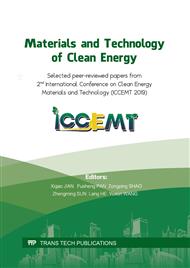[1]
Tashima D, Otsubo M. Relationship between space charge and effective pore size of nanoporous electrode in electric double-layer capacitor, J. Particuology, 2011, 9(1):91-94.
DOI: 10.1016/j.partic.2010.07.021
Google Scholar
[2]
Kandalkar S G, Dhawale D S, Kim C K, et al. Chemical synthesis of cobalt oxide thin film electrode for supercapacitor application, J.Synthetic Metals, 2010, 160(11):1299-1302.
DOI: 10.1016/j.synthmet.2010.04.003
Google Scholar
[3]
Genc R, Alas M O, Harputlu E, et al.High-capacitance hybrid supercapacitor based on multi-colored fluorescent carbon-dots, J. Scientific Reports, 2017, 7(1):11222.
DOI: 10.1038/s41598-017-11347-1
Google Scholar
[4]
Ramadoss A, Saravanakumar B, Kim S J. Vanadium pentoxide/reduced graphene oxide composite as an efficient electrode material for high-performance supercapacitors and self-powered systems, J.Energy Technology, 2015, 3(9):913-924.
DOI: 10.1002/ente.201500059
Google Scholar
[5]
LEI Z B, ZHANG J T, Zhao X S. Ultrathin MnO2 nanofibers grown on graphitic carbon spheres as high-performance asymmetric supercapacitor electrodes, J. Journal of Materials Chemistry, 2011, 22(1):153-160.
DOI: 10.1039/c1jm13872c
Google Scholar
[6]
LIU Y R. Carbon materials for supercapacitor application. Beijing, (2013).
Google Scholar
[7]
DU R, QIN A M, WEI C, et al. Research progress of preparation of biomass carbon and its electrochemical application, J. Materials Review, 2014, 28(5):93-97.
Google Scholar
[8]
Kim Y J, Lee B J, Suezaki H, et al. Preparation and characterization of bamboo-based activated carbons as electrode materials for electric double layer capacitors, J.Carbon, 2006, 44(8):1592-1595.
DOI: 10.1016/j.carbon.2006.02.011
Google Scholar
[9]
WANG H L, XU Z W, et al. Interconnected carbon nanosheets derived from hemp for ultrafast supercapacitors with high energy, J. ACS Nano, 2013, 7(6):5131-5141.
DOI: 10.1021/nn400731g
Google Scholar
[10]
WANG X Z. Electrochemical and gas adsorption properties of biomass porous carbon materials., Beijing, Beijing University of Technology, (2018).
Google Scholar
[11]
Li H, Wang J, Chu Q, et al. Theoretical and experimental specific capacitance of polyaniline in sulfuric acid, J. Journal of Power Sources, 2009, 190(2):578-586.
DOI: 10.1016/j.jpowsour.2009.01.052
Google Scholar
[12]
Cheng Q, Tang J, Ma J, et al. Polyaniline-coated electro-etched carbon fiber cloth electrodes for supercapacitors, J. Journal of Physical Chemistry C, 2011, 115(47):23584-23590.
DOI: 10.1021/jp203852p
Google Scholar
[13]
Tantawy H R, Weakley A T, Aston D E. Chemical effects of a solvent-limited approach to HCl-doped polyaniline nanopowder synthesis, J. The Journal of Physical Chemistry C, 2013, 118(2):1294-1305.
DOI: 10.1021/jp410119n
Google Scholar
[14]
Zhang Q Q, Zhang Q W, Lu H, et al. A comparative study of electrochemical capacitance of graphene oxide affected by oligomers of p-Phenylenediamine and hydrazine hydrate in solvothermal condition, J. Journal of Wuhan University of Technology Materials Science, accepted in printing.
DOI: 10.1007/s11595-020-2251-3
Google Scholar
[15]
Zhang Q Q, Zhang Q W, Wang W H, et al. Study on graphene oxide modified by oligomers of p-phenylenediamine for supercapacitors, J. Journal of Mining Science and Technology, 2019, 4(6):558-563.
Google Scholar
[16]
Hao G P, Li W C, Qian D, et al. Rapid synthesis of nitrogen-doped porous carbon monolith for CO2 capture (Adv. Mater. 7/2010), J. Advanced Materials, 2010, 22(7):853-857.
DOI: 10.1002/adma.200903765
Google Scholar
[17]
Sun D, Ban R, Zhang P H, et al. Hair fiber as a precursor for synthesizing of sulfur-and nitrogen-co-doped carbon dots with tunable luminescence properties, J. Carbon, 2013, 64(Complete):424-434.
DOI: 10.1016/j.carbon.2013.07.095
Google Scholar
[18]
Kan K, Wang L, Yu P, et al. 2D quasi-ordered nitrogen-enriched porous carbon nanohybrids for high energy density supercapacitors, J. Nanoscale, 2016, 8(19):10166-10176.
DOI: 10.1039/c6nr01094f
Google Scholar
[19]
Xu G, Dou H, Geng X, et al. Free standing three-dimensional nitrogen-doped carbon nanowire array for high-performance supercapacitors, J. Chemical Engineering Journal, 2017, 308:222-228.
DOI: 10.1016/j.cej.2016.09.060
Google Scholar
[20]
Wang G, Xing W, Zhuo S. The production of polyaniline/graphene hybrids for use as a counter electrode in dye-sensitized solar cells, J. Electrochimica Acta, 2012, 66(none):151-157.
DOI: 10.1016/j.electacta.2012.01.088
Google Scholar
[21]
Lu W, Liu M, Ling M, et al. Nitrogen-containing ultramicroporous carbon nanospheres for high performance supercapacitor electrodes, J. Electrochimica Acta, 2016, 205:132-141.
DOI: 10.1016/j.electacta.2016.04.114
Google Scholar
[22]
He X, Li X, Ma H, et al. ZnO template strategy for the synthesis of 3D interconnected graphene nanocapsules from coal tar pitch as supercapacitor electrode materials, J. Journal of Power Sources, 2017, 340:183-191.
DOI: 10.1016/j.jpowsour.2016.11.073
Google Scholar
[23]
LI J Q, WANG Q, LI Y Q. Fe-N particles preparation and the electron magnetic performance, J. Journal of Functional Materials and Devices, 2010, 16(1):6-10.
Google Scholar
[24]
Ning X, Zhong W, Wan L. Ultrahigh specific surface area porous carbon nanospheres and its composite with polyaniline:preparation and application for supercapacitors, J. RSC Advances, 2016, 6:25519-25524.
DOI: 10.1039/c6ra00596a
Google Scholar
[25]
Patil S J, Kim J H, Lee D W. Graphene-nanosheet wrapped cobalt sulphide as a binder free hybrid electrode for asymmetric solid-state supercapacitor, J. Journal of Power Sources, 2017, 342:652-665.
DOI: 10.1016/j.jpowsour.2016.12.096
Google Scholar
[26]
Singh A P, Chandra A. Enhancing specific energy and power in asymmetric supercapacitors -a synergetic strategy based on the use of redox additive electrolytes, J. Sci Rep, 2016, 6:25793.
DOI: 10.1038/srep25793
Google Scholar


